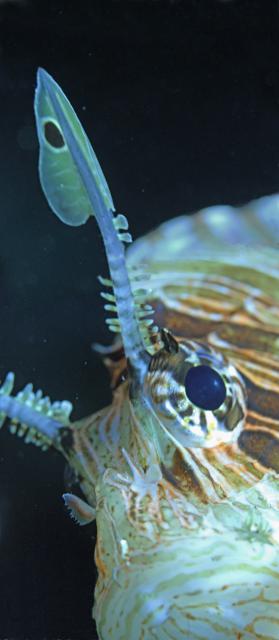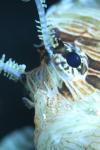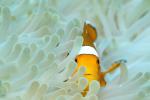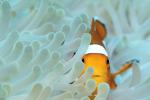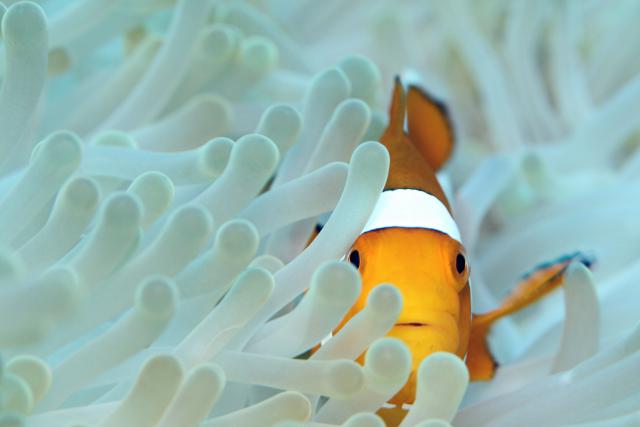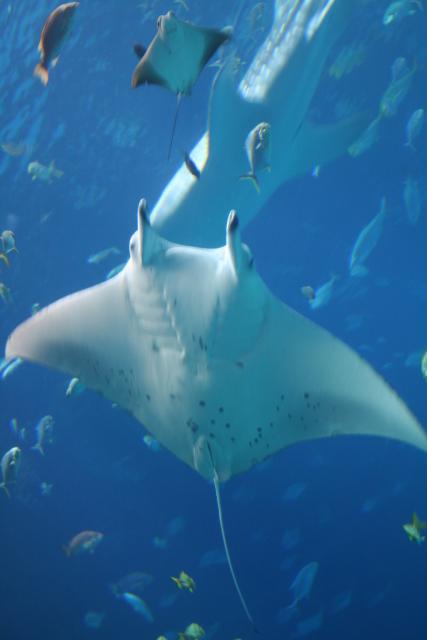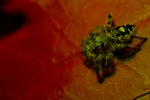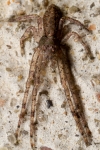fish
Wakatobi: House Reef Assortment
ktuli — Tue, 02/15/2011 - 19:44
Ok - I'll skip all the blabbering today. Instead I'll just give a nice little assortment of some of the absolutely incredible stuff we got to see just stepping off the beach and diving on Wakatobi's house reef.

Banded Sea Snake (Laticauda colubrina)
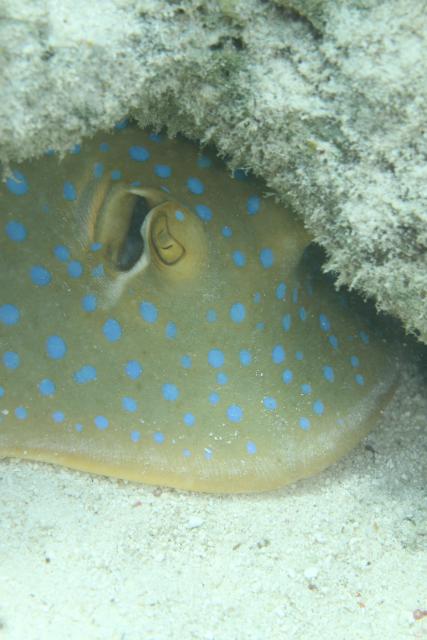
Blue-Spotted Ribbontail Ray (Taeniura lymma)

Crocodile Flathead (Cymbacephalus beauforti)
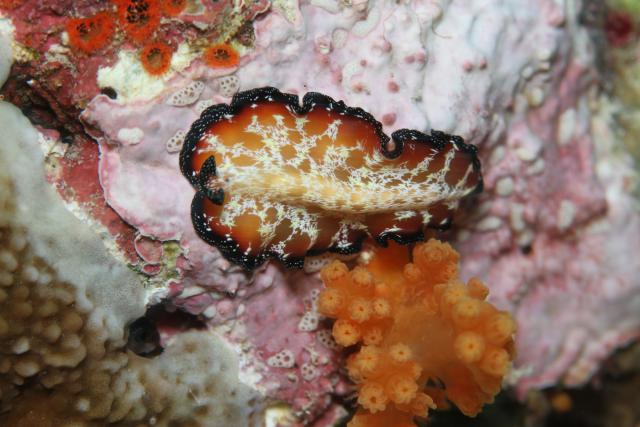
Lightning Flatworm (Pseudobiceros fulgor)
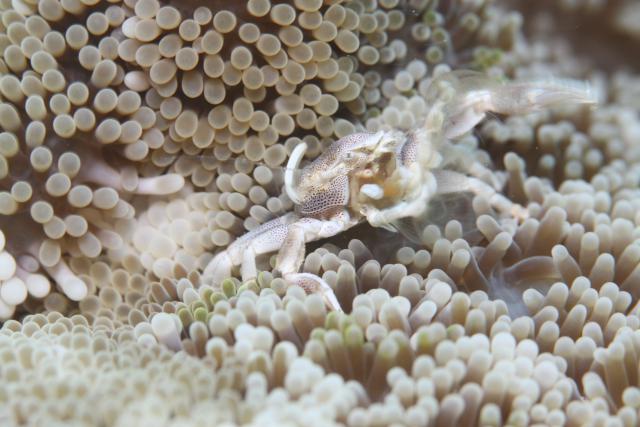
Spiny Porcelain Crab (Neopetrolisthes spinatus)

Twinspot (sometimes also Fu Manchu in the pet trade) Lionfish (Dendrochirus biocellatus)
I wish we had had another week that we could have spent just diving the house reef over and over. Perhaps next time!
- Bill
Wakatobi: Photoshopped Lionfish
ktuli — Mon, 02/14/2011 - 19:38
I spent the afternoon fixing up some photos to print so we can frame them and decorate one of our walls with photos from our trip. While I was doing so, I decided to attempt something a little more aggressive.
During one of our last few dives, I decided to work in close to one of the Common Lionfish (Pterois volitans). In Cozumel, seeing one of these guys is a very bad thing. They are incredibly invasive and the reef fish in the Caribbean simply aren't ready to compete with them. However, in Indonesia, they are native and thus are in balance.
As I was working with the lionfish, I managed a couple good shots, but afterwards realized that two of the shots had elements that worked individually but I had not managed a single shot with all of the elements combined.
As you can see, the first shot does a great job of capturing that really cool modified "eye-brow" fin but cuts off too much of the face, whereas the second is a good close-up of the fish's face, but is missing the "eye-brow". So I got the idea to combine the two shots to get one single photo with everything. I also decided to stick with the extra long/narrow vertical format it produced.
Unfortunately, the two exposures were slightly different, so there was a lot of adjustments needed to get the colors to match. This required adjusting the colors and brightness and contrast several times - oddly to match the antenna took one batch of changes, while to match the rest of the face took another different batch.
Additionally, the scale of the two shots were also different, which luckily by overlapping some elements, I was able to match things up in that respect. The easiest technique I found for achieving this was to turn down the opacity of one layer and resize and move that layer until things matched up.
In the end, there is still one section that I am not exactly thrilled with how to came out. I'm not going to point out what it is, because I am wondering if I notice it because I sat working on it all afternoon. If you think you know which area still could use some work, drop a comment and let me know.
Technical Data: Canon EOS 7D, Canon EF 100mm f/2.8L Macro IS USM, 1/170th and 1/130th sec respectively at f/8. Image Stabilization on. ISO 1600 and 1000 respectively (Auto). Ikelite Housing and Port with Ikelite DS161 Strobe in TTL Mode.
This is by far the most complex amount of photoshopping I've attempted. Usually I prefer to only make minor subtle modifications, but this little project was fun - I just don't think I'll be doing anything like this too often.
- Bill
Poll: Wakatobi: False Clownfish
ktuli — Tue, 02/08/2011 - 21:22
First off, my apologies for the delay in getting to these posts. After getting home from the trip, I realized I had taken over 6600 exposures (mostly due to the camera being set to high speed burst mode). I spent time removing any photos that we're up to par or just duplicates due to the high speed bursts, and trimmed the set down to around 1750. I meant to go through posting photos from the trip in a chronological order, but I know some folks are waiting for this one, so we'll bounce around a little here to start.
The photo was taken towards the end of the week at the Roma dive site. All week long, I'd been enjoying taking photos of the various anemonefish, and this particular set of False Clownfish (Amphiprion ocellaris) provided a nice opportunity for several great shots.
This one, however, was selected by our dive-masters as the "Photo of the Week" for our week. I was absolutely flabbergasted by that announcement. My underwater photography improved by leaps and bounds each dive during this trip, but I still consider that luck was a very (very) large factor in what I came back with. In the coming posts, we'll discuss some of the ways in which the underwater photography improved.
As I said, I was running the camera in high speed burst mode (providing up to 8 frames per second with my Canon EOS 7D) which helped with my luck in capturing the fleeting moments that occur with the constant movement of the subjects, but I distinctly remember seeing this shot develop in the viewfinder and knowing then that I had captured something nice.
When the shot was presented by our dive-masters at the dinner slideshow, it was slightly modified, so I attempted to duplicate those modifications as best I could here. Mouseover each thumbnail below to see the different versions, then place your vote below to let me know which version you prefer (leave a comment with details as to why you selected what you did if you like).
|
|
|
Technical Data: Canon EOS 7D, Canon EF 100mm f/2.8L Macro IS USM, 1/40th sec at f/8. Image Stabilization on. ISO 400 (Auto). Ikelite Housing and Port with Ikelite 161 Strobe in TTL Mode. Modified version cropped and auto-smartfix in Photoshop Elements 8.0
The modifications are very subtle (as I usually feel any post production modifications should be). Initially, the shot was cropped specifically to make the the fish rest right on the intersection of two of the thirds. Then I ran the shot through Photoshop Elements 8.0's Auto-Smart-Fix to adjust some colors (producing a bit more bluish tint to the anemone and darkening the orange of the False Clownfish).
I know I've mentioned before that I should start selling prints, but I haven't gotten setup to do that yet, even with some requests for this photo specifically. So for now, enjoy it for free if you'd like. Here are the links to the fullsize versions - Original and Modified - for use for printing or as a wallpaper (be sure to resize first, or use the smaller version above).
Thanks for stopping by today, and be sure to visit back frequently over the coming days/weeks as I will be continuing all the updates from the trip. And don't forget to place your vote below, and leave a comment as to why you voted as you did.
- Bill
PS: Alastair, enjoy the photo, perhaps we'll meet again underwater some day in the future. Best of luck getting certified!
 PPS: As a 'prize' for the 'Photo of the Week', the fantastic staff at Wakatobi presented me with a fabulous cake made up to be a coral reef. The cake was absolutely fantastic and I shared it with our entire group! The pink stuff on the right is some strawberry roll which was my favorite dessert of the week, and the staff were attentive enough to notice that and give me one of the leftover pieces as additional 'prize'! If anyone from Wakatobi is reading this, thanks again for a most memorable week!
PPS: As a 'prize' for the 'Photo of the Week', the fantastic staff at Wakatobi presented me with a fabulous cake made up to be a coral reef. The cake was absolutely fantastic and I shared it with our entire group! The pink stuff on the right is some strawberry roll which was my favorite dessert of the week, and the staff were attentive enough to notice that and give me one of the leftover pieces as additional 'prize'! If anyone from Wakatobi is reading this, thanks again for a most memorable week!
Indonesia: Sneak Peek (part 2)
ktuli — Sat, 01/29/2011 - 03:05
Wow! Just wow!
So far, we have 12 dives in on this trip, and I've been getting more and more fantastic shots. I've been learning how to better use my gear, as well as how to just dive better (ie: better buoyancy control, better air comsumption, etc), but more on all of that later.
We've seen things we've never seen before, and stuff we've only ever seen in books. I have a very small selection to share today, including: some anemone fish, shrimp, crocodile fish, and sea stars. I've also got a good collection of nudibranch shots going, but I'm going to be stingy with those until I get home... ;)
Enjoy these for now:
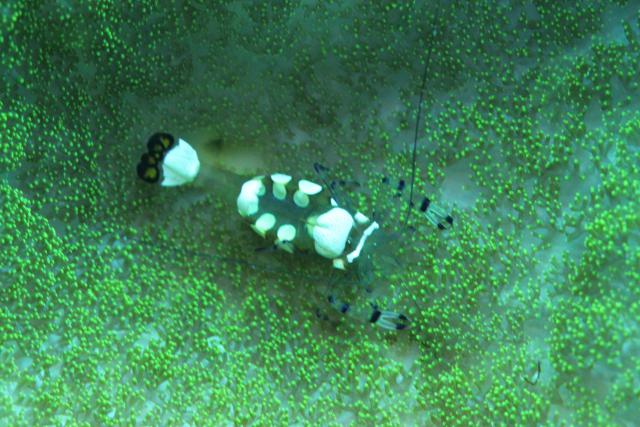
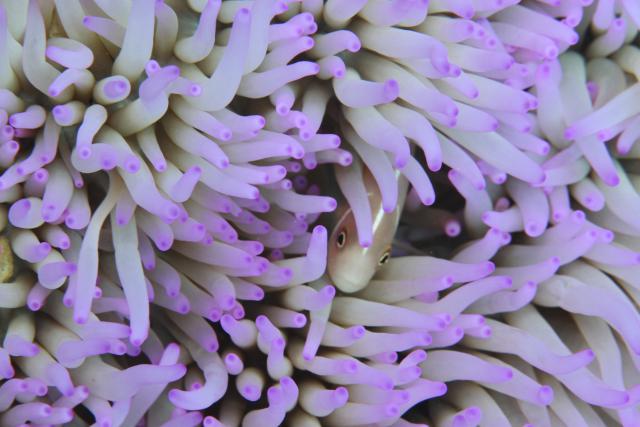
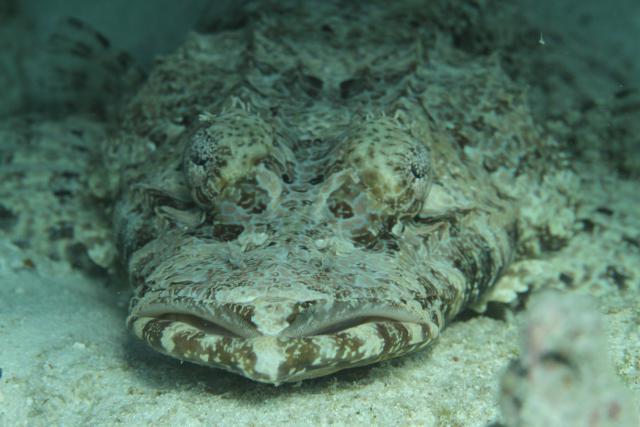
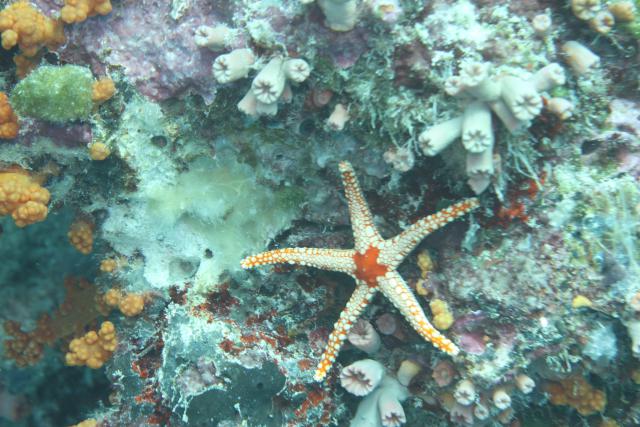
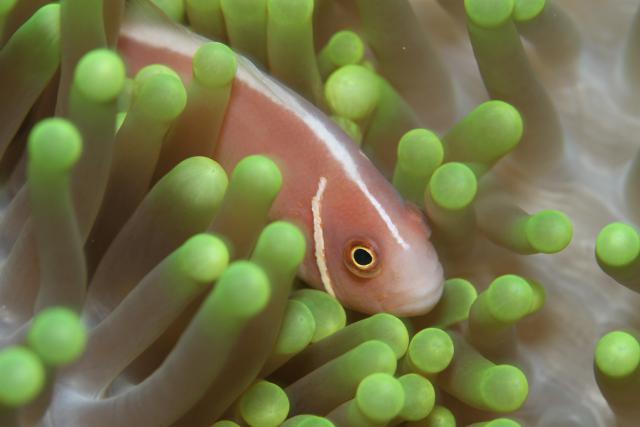
Our afternoon alarm just went off, so we now have to go head out for our second twilight dive!
- Bill
Some More Underwater Photoshopping
ktuli — Tue, 01/11/2011 - 20:45
Sorry - these photos are not from the new Ikelite equipment or even from our new SeaLife DC1200 compact camera. They actually came from a rented SeaLife DC800 camera during our trip to Cozumel, Mexico last summer.
All the work preparing for the upcoming trip to Wakatobi in Indonesia and working with the new Ikelite gear for the 7D and reading up on dive photography has me thinking about these old photos. More specifically, it has me thinking about whether I can salvage anything from these old photos that didn't turn out so well (and perhaps to prepare for any adjustments I'll have to make to any new photos I come home with.
Surprisingly, all I did with these photos was to run them through the Auto Color Correction and Auto Smart Fix. Pretty easy, but the results are fairly impressive. The second photo was cropped slightly as well.
Mouseover each image for the original to compare...
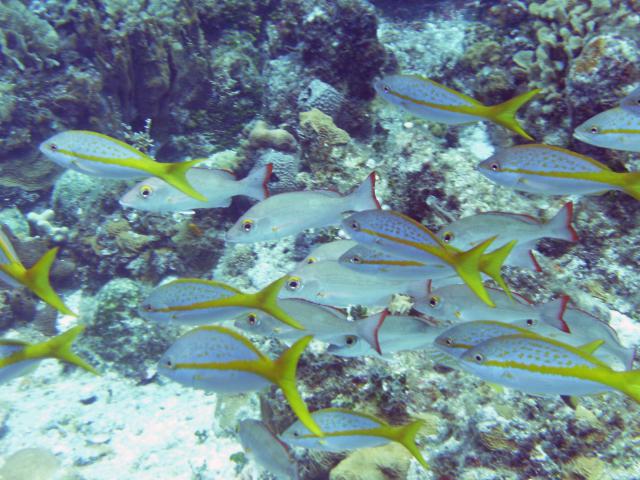
Technical Data: SeaLife DC800 at 13.8mm, 1/80th sec at f/4.7, ISO 64. No Flash. Auto Color Correction, Auto Smart Fix in Photoshop Elements 8.0. Colombia Shallows, Cozumel, Mexico.

Technical Data: SeaLife DC800 at 4.6mm, 1/160th sec at f/5.3, ISO 64. No Flash. Cropped, Auto Color Correction, Auto Smart Fix in Photoshop Elements 8.0. Colombia Shallows, Cozumel, Mexico.
The top photo is of a group of Yellowtail Snapper (Ocyurus chrysurus) while the second shot is of a school of Blue-Striped Grunts (Haemulon sciurus - at least I think so.
Hopefully I don't have to do any post production work on the photos I bring back from this upcoming trip, but if I do, hopefully they are as easy as these!
- Bill
Cozumel 2010: Wrap Up
ktuli — Thu, 07/01/2010 - 19:49
So before everyone gets tired of scuba photos (especially ones with bad blue color casts), I'll wrap this set up and we'll get back to some land based photography soon.
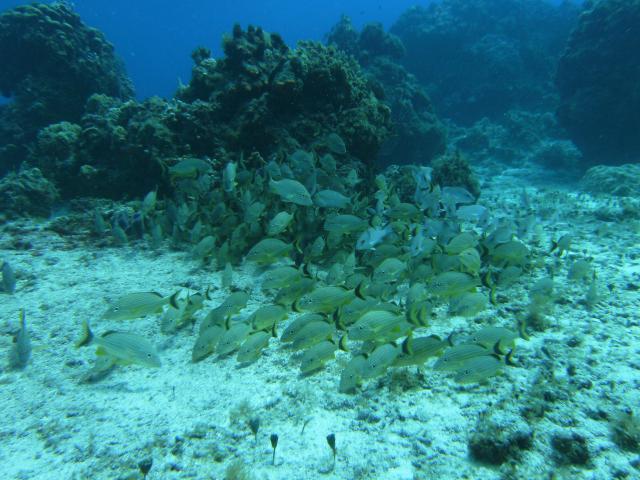
This school of fish sat right at the front of this coralhead where two channels split off to each side. At first, they blended right into the slope of the coralhead. Then as I knelt there getting set to take a photo, the school pulled in close to each other, then spread out, shifting and pulsing to maintain their prized position. It is fun for me to watch fish behavior - whether it be individuals or whole schools of fish. For underwater photography, I feel schools of fish like this fall into a kind of "landscape" photography while still being wildlife photography.
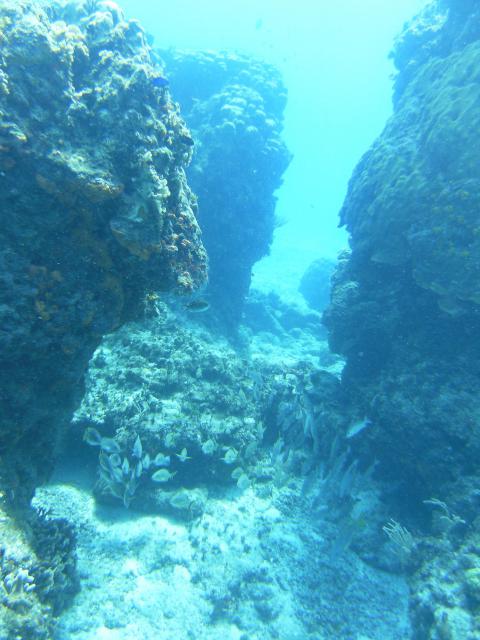
Though this photo is definitely over-exposed, I liked this one as a nice shot of the way the coral and structure is is Cozumel. Our general dive provide per day would be three dives (two morning and one afternoon) - with each dive becoming progressively shallower. The first dives would usually be in the 70-90 feet range, and sometimes would include swim-thrus. In some cases, these swim-thrus would include complete tunnels and other times it would be open like this. This particular set of formations were actually at a more shallow dive site, but some of the sites had formations right out by where the depth drops off into the deep blue. This is usually referred to as 'the wall'. There's something fun yet a bit nerve wracking about being exposed out on the edge of the wall with nothing but deep dark blue next to you - but I do always scan the blue to see if something cool might make a brief appearance there.
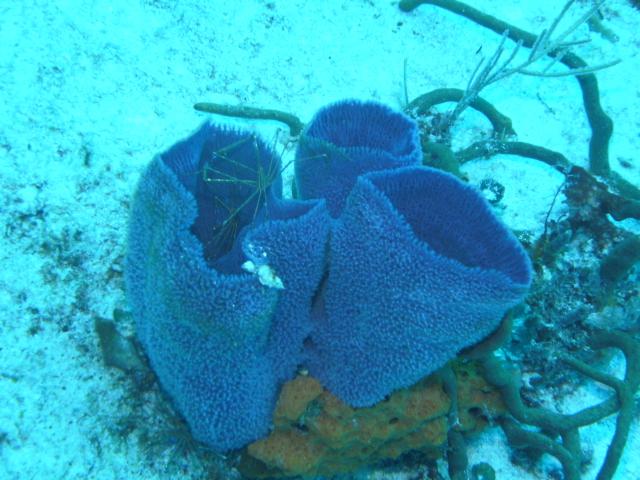
This shot was actually a surprise for me. I can recall Anya pointing out these two arrow crabs, but I didn't remember taking the photo, and it turned out to be a fairly nice one. These arrow crabs are cool little creatures. We saw more of them last year, but it was still nice to see a handful of them this year. Eventually I'm sure these guys will become macro subjects for me, but that'll have to be another dive trip.
Thanks for stopping by and checking out all the photos and dive stories from our trip to Cozumel this summer. I apologize for the blue color cast to most of the photos. Hopefully next time I'll do better at figuring out what I am doing wrong and come home with better photos.
- Bill
Cozumel 2010: Assortment
ktuli — Wed, 06/30/2010 - 19:37
Just an assortment of photos today... enjoy.
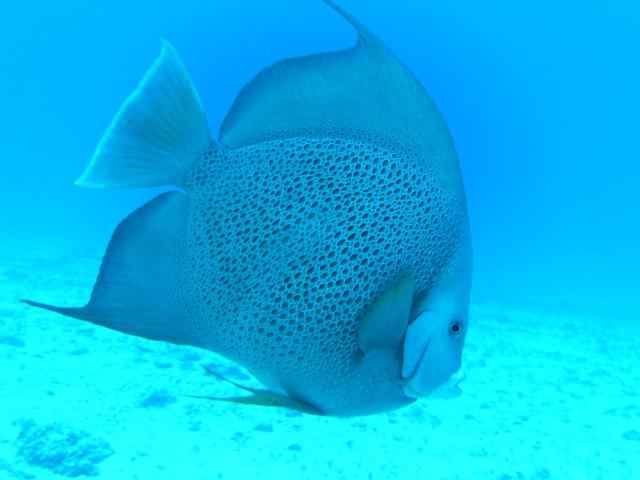

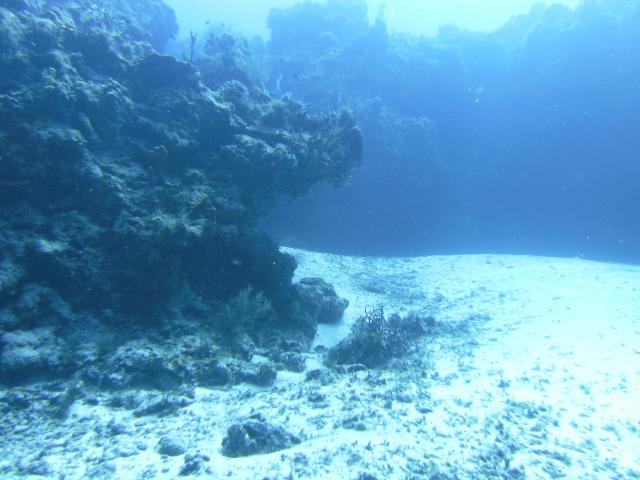
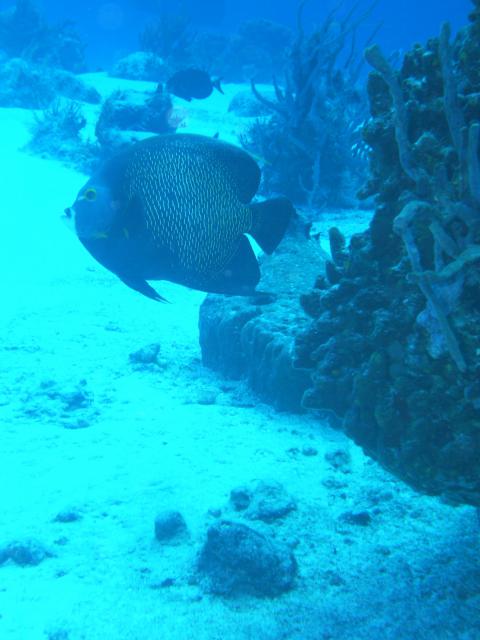
Feel free to leave a critique in the comments if you like.
- Bill
Cozumel 2010: Small and Large
ktuli — Mon, 06/28/2010 - 20:28
Two more photos to share with you today. One of probably the smallest subject I photographed and one of definitely the largest animal I photographed during the dives. Again, I apologize for the bad blue color cast to the photos, these really aren't great photos, but I wanted to share them anyway.
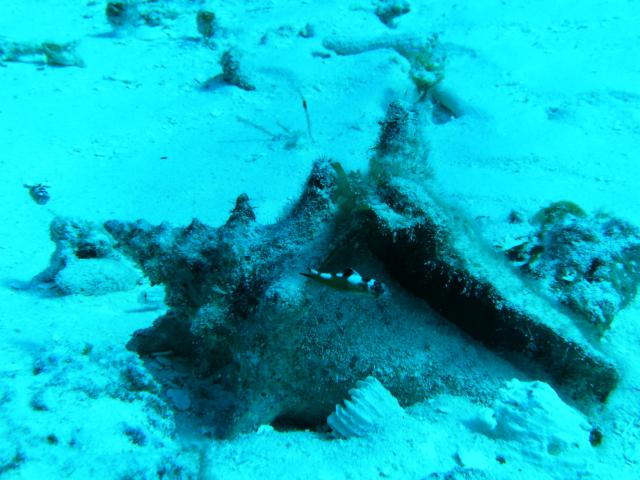
If you're confused at what you're looking at there, I apologize, the scene was really much more interesting without that blue color over everything. Almost dead center of the photo, you'll see a small fish. There was a pair of these fish using this shell as a home (the other is on the left edge of the photo, but facing the camera and thus hard to distinguish). They were black and white and orange (I think it was orange, but I am second guessing myself now) and I almost completely missed them, but cause a flash of color as they darted into their shell. I managed to get myself down and out of the current and sat patiently waiting until they came back out of their hiding spot and went back about their business. They really were fantastic little fish, and I wish I could have come back with a better photograph of them. Oh yeah - and they couldn't have been more than half an inch long.
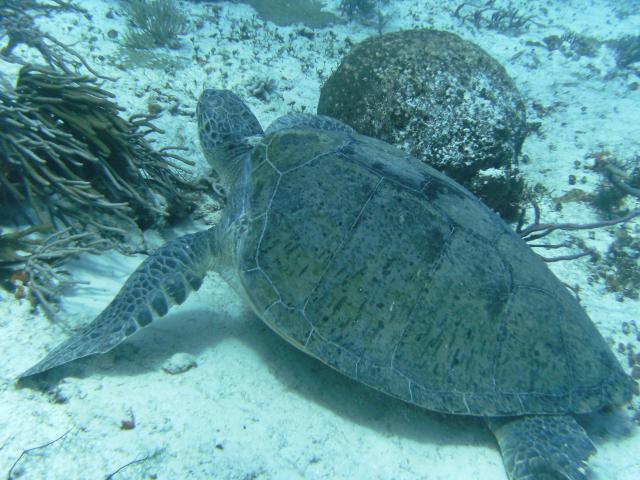
This guy, on the other hand, was absolutely massive. No lie, he was the size of a small car. I would have liked to have gotten a shot of him with something to give the photo some scale, but when we drifted by him, the current was pretty strong. I was towards the front of the group when we saw this behemoth, and honestly I didn't realize what I was looking at was a turtle at first. He had his head tucked under the coral branches you see in the left of the photo. As our group approached, he gently lifted his head, checked us out, and decided it was time to find somewhere else to nap. There is someone in our neighborhood that has one of those Smart Cars, and I think this this was about the same size as that car. We saw turtles on pretty much every dive we went on last week (including one that landed on our instructor - Mike's shoulder and kicked me in the hand and camera when he swam away), but this one really will stick with me. The others were all generally smaller and had that typical fun quality that sea turtles have to them, and produced a kind of happy, carefree feeling to watch them. This one, however, just seemed to strike me with an overwhelming sense of awe and reverence - to be in the presence of a creature so massive and obviously so old (if I had to guess, this particular turtle was probably three times my age). I remember thinking that this is why I enjoy scuba diving so much - so that I can experience these kinds of creatures first-hand instead of seeing them only on nature documentaries (which I watch tons of). But at the same time, I felt the twinge of sadness knowing that we're destroying the habitat and environment for such majestic creatures such as this.
Large or small, both of these encounters are things I won't soon forget. I know the photos I have of them aren't that clear, but the memories I brought back certainly are.
- Bill
Cozumel 2010: Intro
ktuli — Thu, 06/24/2010 - 19:30
Well, I apologize for the long silence in posting, but Anya and I were on vacation last week. We took another dive trip down to Cozumel, Mexico. We go diving with the group we got certified with - Divehards International. This is the second time to Cozumel, and both times we stayed at Hotel Cozumel & Resort and dove locally there with Dive Paradise.
This year, I rented a Sealife DC800 (8 MP) camera and strobe. I have a deal worked out with Divehards International to be purchasing a DC1000 (10 MP) camera and strobe and wide-angle lens kit here shortly. So I will have a dedicated underwater camera that I own since it doesn't look like I will be affording the housing, strobe and arm, and dome port I need to take my 7D underwater (unless someone wants to make a sizable donation) because we're trying to save up for our next dive trip which will hopefully be Wakatobi Restor in the Southeast Sulawesi Sea in Indonesia!
Anyway - back to Cozumel... The majority of the photos from last week did not turn out that great. I think a lot of these will need to be run through Photoshop (once I can figure out the necessary set of adjustments to make). We had some very weird currents while diving last week, so I ended up not being as close to the corals as I would have liked for many shots, and that combined with rookie work with the strobes really made for sub par photos.
So I won't be critiquing these photos, but I'll share some of the most decent ones as well as sharing some dive stories along with them over the next couple days.
I'll start with some photos from our first dive of the week. When we arrived on Saturday, basically the first thing we did was check into the hotel and head for the water to do a check-out dive to get our boyancy figured out and get into the groove of things. Anya and I probably spent 40 minutes or so in the water and I took several shots including this one of this puffer fish.
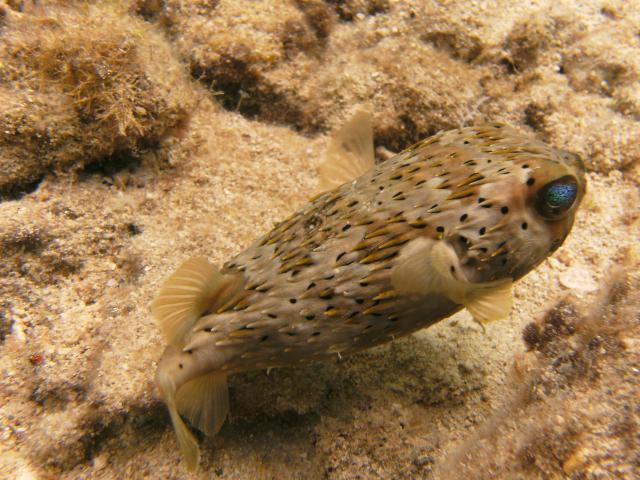
Check out how awesome his eye looks! Unfortunately, it was the last photo all week that turned out nice. About midway through the dive, we stumbled into a field of sea stars that were really cool looking. Some of them were at least 14 inches across, and they were yellow with red or black spikes along them (it was tough to tell the color of the spikes, especially since the red spectrum is the first to go away underwater).
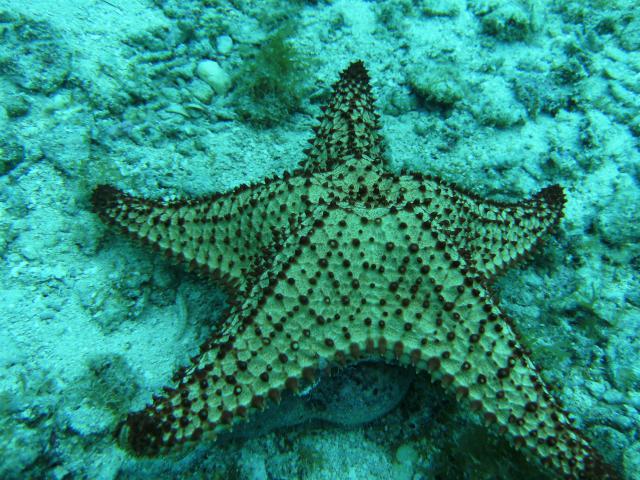
See the bluish color cast to the photo? Get used to it, because that's what is wrong with every other underwater photo I took last week. I am not sure if it was the flash intensity, the flash direction, the flash in general, or whatever other factor could be coming into play, but it is one I definitely will need to sort out before taking too many photos in Indonesia.
Stay tuned for more photos from the trip, and some fun dive stories!
- Bill
Let's Talk Convergence
ktuli — Sun, 03/14/2010 - 21:10
First off, this is not a great photo. It actually is a fairly bad photo. It has a major flaw with it.
Contrary to what this photo looks like, manta rays do not eat whale sharks (unless you're making a B rate sci-fi movie).
The problem with this photograph is known as a convergence or merging.
Basically, when I took this photo, I wasn't paying enough attention. My focus was all on the manta ray (and sadly even that isn't even in focus!).
I did not notice the whale shark entering into the background, and wait too long before tripping the shutter.
The result? A photo that makes it appear that the manta ray is trying to eat a whale shark. Trust me - like I said, that just doesn't happen. Both animals actually eat plankton, or basically small marine animals that aren't any larger than a quarter. Tiny shrimps and other small marine animals that float in the water.
I am going to make up some excuses for myself here...
First, all of the animals in the photograph are constantly moving - this is probably the biggest reason for convergences like this. When you have multiple subjects constantly moving and you are tracking to track one of the subjects, you sometimes lose track of the others and this can happen.
In addition, this photo was taken at the Georgia Aquarium's Ocean Voyager main viewing window. A 23 feet tall by 61 feet wide by 2 feet thick sheet of acrylic (currently the second largest aquarium viewing window in the world) in a darkened room. Multiple factors that all team up for difficult photography.
But in reality, none of these are excuses for converging subjects.
Keep an eye out for this in your own photos and try to avoid it. Definitely don't let it happen with stationary elements in your photos. It is distracting, and quite often ruins photos.
Technical Data: Canon EOS Digital Rebel XT, Canon EF-S 18-55mm f/3.5-5.6 II at 55mm, 1/15 sec at f/5.6, ISO 400. No post production. Georgia Aquarium, Atlanta, GA.
So enough beating up on my own photography for a bit... now I am going to babble a bit about the trip itself.
This particular visit to the aquarium was our second trip. The first time the aquarium did not have the manta ray. However, this second time, we were scuba certified, so we took advantage of the aquarium's Journey with Gentle Giants program.
Yeah, some might call it cheating, but Anya and I have gotten to swim with whale sharks, manta rays, hammerheads, and a ton of other stuff. And as fascinating as whale sharks are, I've always loved manta rays.
During our dive, there was a point at which the manta ray swam no more than a couple feet above me. I managed to roll over on my back and swim underneath it and watch as it glided through the water above me. Has they not had strict rules about touching the animals, I could have easily reached up and ran my hand along its belly.
On one hand, I wished I could have had a camera with me, but on the other hand, I am glad that I didn't so I could just experience the dive.
But underwater photography is something I'll be getting into more and more. Now if only someone would donate a couple Ikelite housings to the cause...
Ok - that is a long enough post for today. I'm going to wander off to look through a new Coral Reef photo book I bought over the weekend.
Enjoy the remainder of your weekend (or here's hoping your Monday is starting off smoothly).
- Bill

